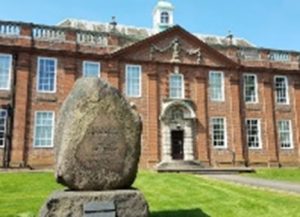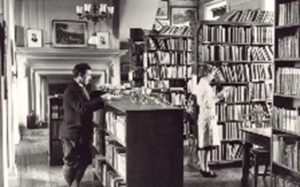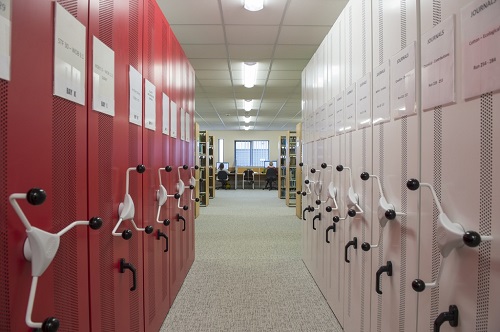Library of the Week: 1st August: This week we feature Rothamsted Research Library, one of the oldest, specialist agricultural collections in the UK. Find out more about the library and its history in this great post by Chris Whitfield (Library and Information Services Manager at Rothamsted Research.)
Rothamsted Research is the longest-running agricultural research institute in the world, nestled in the Hertfordshire commuter belt. Its particular focus is research related to wheat, although it also has a site in Devon, specialising in research into cattle and dairy farming and does research into other areas of biosciences.
It was founded in 1843 when John Bennett Lawes, owner of the Rothamsted Estate and pioneering businessman in the fertilizer industry, appointed Joseph Henry Gilbert, a chemist, as his scientific collaborator. They planted the first of what were to become the classical Rothamsted Long term experiments involving wheat grown with various degrees of fertilizers. The partnership between Lawes and Gilbert lasted 57 years and together they laid the foundations of modern scientific agriculture and established the principles of crop nutrition. The long-term experiments provide a unique resource, with the data from them being held in the library archive, although much of it is now digitised.

In 1889, Lawes placed in Trust his laboratory and experimental fields at the Rothamsted Estate, together with the sum of £100,000. His purpose was to ensure the continuation of the agricultural investigations at what had become known as the Rothamsted Experimental Station (RES). During the 20th century, government progressively increased its support for research in agricultural food production, in response to pressures created by the two World Wars and a burgeoning urban population.
During the 1920s and 1930s the institute hosted the work of Ronald Fisher, who was a biologist, geneticist and one of the founders of modern statistical science. He initially was tempted to Rothamsted, in part, because of the vast amount of crop data the institute had accumulated.
In the 1980s government support for agricultural research declined, partly in response to increases in yields since the Second World War and the belief that the issue of agricultural production was ‘solved’. In 1986, Rothamsted was merged with several other institutes; Long Ashton Research Station, Broom’s Barn Experimental Station, and the Unit of Insect Neurophysiology and Pharmacology at Cambridge, thus forming the Institute of Arable Crops Research (IACR). In 2003, this was restructured and became Rothamsted Research Ltd (RRes), including the integration of research and more than 50 scientists from other institutes. North Wyke Research in Devon, was merged with RRes in 2009, adding substantial capacity in grazing-livestock systems and environmental research.

Rothamsted is a leader in several areas of bioscience, with gene editing for use in crops being an important area. The institute was the scene of protests, which featured in national news, in 2012. Genetically modified crops, which had previously been developed in strict laboratory conditions were trialled outside in field conditions. Several of our scientists are very public supporters of modern farming methods and the potential benefits that gene edited crops might offer.
Rothamsted Library

Rothamsted Library is one of the oldest specialist agricultural collections in the UK. It reflects the Institute’s research interests, with comprehensive collections of books and journals in soil science, plant sciences, agronomy, entomology (including apiculture), nematology, pesticide science, plant diseases, mycology and biomathematics.
Having such a narrow specialism puts us in an unusual position. Some of our collections receive very little use, but include the only publicly available copies of certain publications.
The Library at Rothamsted began as a small collection of books belonging to Sir John Lawes. This was augmented in 1913 by the addition of Sir Henry Gilbert ‘s library which was presented by his widow. There are now a large quantity of volumes dealing not only with agriculture but all the allied sciences.
Lawes and Gilbert visited many countries and agricultural experimental stations around the world and Rothamsted exchanged its annual report for publications from around the world, acquiring material from former colonial territories, Russia and the USA. It has a large collection of monographs relating to agriculture.
The library archive contains material relating to all the events described in Rothamsted’s history, above, including large amounts of experimental data. It also holds a collection of livestock prints and paintings of British farm livestock 1780-1910. Interestingly it includes letters between heads of the institute and famous figures, such as Charles Darwin and Ernest Shackleton. This material is a bit of a treasure trove which can still turn up things that are wholly unexpected.

These days the library service has two members of staff (down from eight in the early 1990s). We are primarily an information service for scientists and students at our own institute. We also spend a lot of our time managing open access publishing for our scientists. We are open to the public by arrangement (contact library@rothamsted.ac.uk)
Books, journals and staff publications can be searched on our catalogue, https://rothamsted.soutron.net/Portal/Default/en-GB/Search/SimpleSearch
The electronic Rothamsted Documents Archives (including data from the long term experiments) can be found here http://www.era.rothamsted.ac.uk/eradoc/collections.php
Chris Whitfield – Library and Information Services Manager
You can explore the library’s collections on Discover and find further contact details on their Discover information page.
All images are copyright of Rothamsted Research, reproduced with kind permission of the copyright holder.

